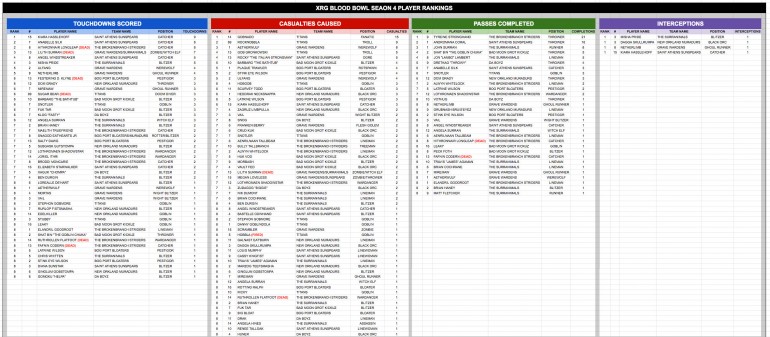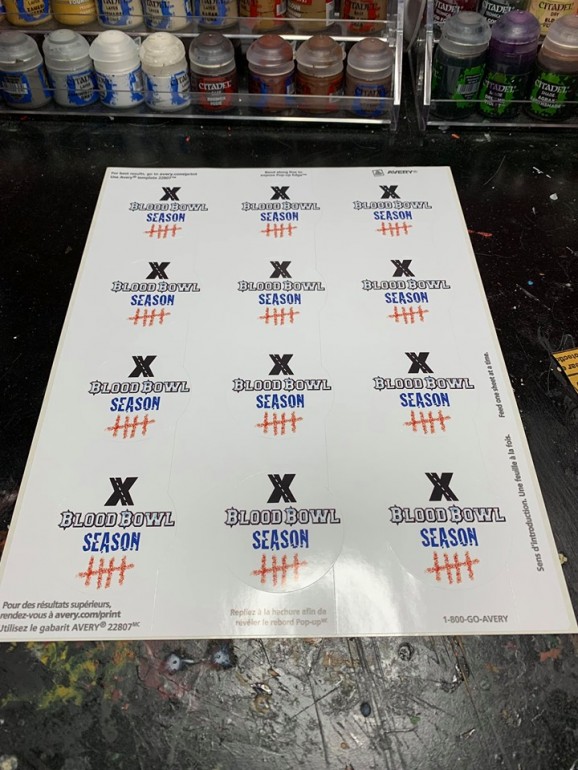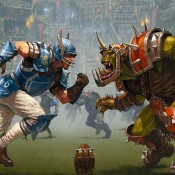Right now the shop I play at is in its 5th season for the Blood Bowl league I run. The league started in 2016 and it has only gotten progressively better each and every season since it began.
This lead me to think it might be worthwhile to write about what I’ve learned. Over those seasons there have been a lot of lessons learned; lessons that are worth sharing.
Blood Bowl League
I’ll try to break this down into digestible segments. Let’s start with the most fundamental element. The players.
This article is about how to run a Blood Bowl league. If you stumbled in here looking for a Blood Bowl guide, then I have that as well.
Recruiting for the League
This is the absolute most critical element to running a successful Blood Bowl league. Getting players is easy. Committed players? That is often a problem.
It’s not hard to find people who say they’re willing to play in a Blood Bowl league. However, it’s very difficult to find players who will actually stick through the season from start to finish.
My Early Seasons
The 1st season of Blood Bowl I ran had a total of 8 players. This seemed a good number to get off the ground with. The problem I ran into was having one player drop entirely, two players played maybe half their games, and another player just dropped out after his first game after being soundly defeated.
Needless to say the season was not a huge success, though we did run through it and learned from it.
The 2nd season was not any better. Ultimately only a few players played any games at all and quite a few just dropped out for various reasons. The 3rd season wasn’t much of an improvement either.
You Need to Find Committed Players
The problem wasn’t how I was running the league; it was simply that I had the wrong people in the league. It does not matter if you’ve run leagues for 20 years or 6 months. If the people aren’t going to give the level of commitment that’s required for a league then it’s going to be less than ideal, if not a complete failure.

Of course, the hard part is taking in only committed players. Meaning, if someone seems interested, but you feel they may not be the most dedicated player, then it’s hard to turn them down, and you don’t have to. Letting in a few questionable players is OK as long as you have a solid core of players already
For those who seem questionable, just be clear with them on what’s required of them. Tell them the time commitment they need to make, the number of games they need to play, the paperwork that goes with playing in a league, etc. You may find that simply laying it all out for them will turn them off of the idea and make life easier on you.
So, all of that is to say that having a dedicated core group of coaches for a league is an absolute must.
Setting up a Schedule for the Blood Bowl Season
Here I’ll cover structuring the league and getting those games setup.
League Divisions
If you read Death Zone: Season 1 for Blood Bowl, then you’ll have read how it’s recommended you setup various divisions for the league – think professional sports.
The first three seasons I did this, two divisions with 4 players each. I had players with a lack of commitment. The problem I ran into was I had two divisions with only 1-2 active players. Now, I had a division where only one game was played and another where two games were played. It just didn’t work.
For my 4th season I went to a single division. The idea being if I had some bad apples, then I had a large enough schedule to compensate and coaches would still get in some games.
The single division worked great. There were still a few coaches with some time commitment problems. However, it all worked out and the season went well.
So, my big advice here is to run a single division of coaches for your first few seasons. Even if you have like 20 players, go with a single division. You’re going to have an attrition of players as the season goes on. Having a simple schedule that doesn’t have to deal with multiple divisions getting in the right games will just make life easier.
If you later find yourself with a good core of players, then look at setting up a few divisions. Having more than one division is great and adds another layer of fun to the game. Just make sure you’ve got a group that can handle it first.
Setting up a Schedule
I do this part very simply. Every coach is set to play every opposing coach at least once. With an 8 team league I’ll schedule 8 games – every team once and double up against one team. You could just do 7 games, one against each team, but who likes an odd number of games? If I had 9 players then it would still be 8 games – every team once.
My general rule for how long the season runs is to allow 1 game a week and then give a bit of a buffer. So, for my 8 game seasons I will run it for 10 weeks. If I were to run a season that was 10 games then I’d give 12 weeks to play them in.
I learned this the hard way too. My early seasons were way longer for less games. The problem was keeping the interest of the coaches. If you were only scheduled for 4 games but had an 8 week season, then it could just drag on and on, and indeed it did.
By keeping the season’s schedule tight, you’re forcing players to get those games in. There’s little wiggle room for goofing off, and in turn you’re keeping their interest. It took me 3 seasons to figure that out but I’m glad I did.
The other good thing with that little buffer in the schedule is that it allows coaches to get in some friendlies too. Friendlies are a great way to let coaches play a game that has value but without impacting their season standings.
If you’ve got a seriously ambitious group then you could tighten up that schedule quite a bit. Death Zone: Season 1 suggests 2 games a week. That’s a bit diehard for my group, but I could see my league going down to 1 week a game, cutting 10 weeks down to 8 weeks.
It’s worth noting too, if you’re new to all this, is that with a schedule what you’re doing is outlining who plays who. You aren’t saying this coach has to play that coach on this date. You’ve giving the coaches their list of opponents, a timeline to play it in, and they play those games as they are able.
That’s another reason for needing dedicated players. It’s a bit of a loose structure, a Blood Bowl league and season, so you need players who can self-manage and do what they need to do.
How to Rank Teams
The standing of a team during a season should be determined by whatever ranking system you’ve come up with. I have tried a few approaches and this is the one I like best.
When a team wins it gets +5pts, a draw is +3pts, and a loss is +1pt.
You accumulate that throughout the season to determine team rankings and in turn seeding for the playoffs.
The reason to give +1pt for a loss, if you’re curious, is it rewards those who play games. You will probably have some players who don’t play all their games, it just happens, so by rewarding those who at least play you are putting them ahead of those who didn’t get in all their matches.
Unlike how Death Zone: Season 1 suggests, I don’t give losses to players who didn’t play all their games. They simply get nothing. Since I rank the teams using the simple formula above (league points), this means players who didn’t play games are more likely lower ranked because they earned nothing for games unplayed.
During the regular season friendlies are allowed but of course those games aren’t ranked. It’s a great way for coaches to gain some more gold, SPP, and maybe walk off some injuries though.
The Playoffs
How you approach playoffs is totally up to you. Some leagues will drop the bottom players and only let through the top teams. Every player gets into playoffs in my league. It’s just more fun that way.
Our approach is pretty much how the NFL does it. It’s a single elimination setup with the best teams playing the worst teams, IE: #1 plays #8, #2 plays #7, etc. The idea being that the top teams will defeat the lower ranked teams and face off in the end.
It’s worth noting that the time schedule I give coaches to play games is only for the season, not the playoffs. The playoffs are an extra few weeks tacked on after regular season. Generally speaking, an 8 game season will run – with playoffs, a total of 14 weeks.
That’s a total of 3.5 months for a Blood Bowl league and why you need a dedicated group of coaches.
Oh, I also do not not allow friendlies during playoffs.
What Goes Into a Blood Bowl League?
The league’s first few seasons were very barebones. We didn’t use pitch rules, special balls, sponsorships, stadiums, etc. The fact is that there’s a lot of stuff you can throw into a league but start off simple. Let coaches get used to how a season works before you throw too many variables at them.
The season that we’re currently running we decided to allow in the special balls, special weather tables, pitch rules, and sponsorships. The coaches currently playing are a very committed group, so we came together, held a coach meeting, and agreed as a league on what to allow and disallow for this season.
We also allowed for the first time the ability to redraft a team. Previously we didn’t, and each new season meant a brand new team. So many coaches decided to redraft that we also decided to let new teams start with 1.25 million gold instead of the standard 1 million. This worked well to help offset a bit the TV disparity and let new teams quickly increase their TV.
This leads me to not only having coach meetings within your league, but just the general idea of running a league how you want. I know some leagues will give new teams an automatic fan factor of 5 to help out against redrafted teams. Other leagues will, as we did, start new teams with more gold than normal. There’s leagues that will give you a few free cheerleaders and assistant coaches too.
The point is, do whatever seems fun, fair, and everyone can agree to. There’s no right and wrong way to structure your league, so don’t feel you need the internet’s approval for anything. Just have fun with it.
Use Statistics for Fun and Friendly Competition
Last season my league started tracking stats. This was one of the best things we ever did.
As the league commissioner, I track all the games played and record those. So, John, another coach, decided to start tracking team and player stats. John tracks touchdowns scored, touchdowns against, casualties caused, etc. Basically, if it’s something you can earn SPP doing then we track it as a stat throughout the season.
While the season is going John is constantly updating that information and each coach is constantly checking to see how they’re ranking against other coaches in the various categories.
Did I get #1 for most touchdowns this week?
Am I leading the league in most casualties caused yet?
This has created some fun rivalries within the league as coaches are trying to top the various charts. It’s also just useful information to have as well.

Last season my Undead faced Humans for the league title. By tracking the stats we knew that Benito’s Humans were the #1 offense in the league and my Undead had the #1 defense in the league. It’s not info we needed to have, but it was info that was fun to have and to see what wins a championship game – the best offense or defense? The answer was offense. I lost that game ;)
You can track anything you want. You can go as simple as you’d like or as complicated. In either case, I do recommend tracking the information because it just keeps every coach involved and having fun even when they aren’t playing a game. Keeping everyone engaged in the league like this goes a long way to keeping coaches participating throughout the season.
Tracking Sheet
Zack, a player in our league, came up with this really simple sheet to track players stats and game information.
After each game, both coaches fill in the sheet and then hand it in or we send a picture of it. From there it goes into the spreadsheet where we track that info. That’s it.
Wrapping it Up
At the end of the day, do whatever you feel makes sense and is in the interest of your fellow coaches. I do suggest keeping it simple early on, build up the interest, get a core group of players going, and then start interjecting some of the more interesting and long term ideas to each season.
The big takeaways (I think) are:
- Dedicated players are critical.
- Keep it simple for the early seasons.
- Have a tight schedule to keep coaches on track.
- Track stats for fun and engagement throughout the season.
- Just have fun and run the league however you all agree to.
I realize I may not have answered the questions you came here looking for answers to, so please leave a comment below with any questions you might have. I was aiming more to give an overview, share some lessons learned, and guide you a bit, not cover every element in detail, but I will gladly discuss details in the comments!
Blood Bowl Stuff
- Creative Twilight’s Future and My Thoughts (Feedback Welcomed!) - December 4, 2021
- My Top Gift Ideas for Miniature Painters & Hobbyists + Gifts to Avoid - December 2, 2021
- The Year That Was 2020 and Where I’ve Been - January 17, 2021






Great article Thor! I can add a little to the stats you were talking about. A fun thing that the stats allow a league to do is to give out awards. In this league we give out 4 player and 4 team awards at the end of the season. For most touchdowns, most casualties caused, etc etc. I like it because even if you lose most of your games, which I tend to do, it gives you other goals to try for. As the league stats master I can tell you though that it can sometimes be a pain getting stats from everyone in a timely fashion. This is also where getting dedicated players in your league will be a big help. I also believe that having the stats being tracked in real time like we do in this league also helps keep people dedicated to the league. All our players seems to really enjoy seeing how their players are stacking up vs the competition.
Thank you.
Yeah, the stats have been a very successful addition to the league. You’re right too in that it gives you something to work towards even if you’re win ratio isn’t that great. I keep eyeing the best defense category, which I currently hold (as of last week), to see if I can have best defense two seasons in a row. Stats are just fun for everyone.
One of the few things I really like about the computer version is how it tracks all kinds of stats. Very cool idea to incorporate that into a Tabletop League.
Agreed. Since we’re all used to the online game it just made sense to work it in.
I’m helping start a blood bowl league and this guide is very helpful. Bunch of questions:
You say that schedule doesn’t mean specific date but does it specific order? Or do your players pick their opponents each week as long as they don’t play the same coach twice. If its a specific order what do you do if the players can’t schedule their game do they skip the week and come back to it later? Does one person concede, do they draw?
To prevent cheating does it make sense to your opponent record your dice rolls for player improvements or am I just being paranoid?
Is their any merit to banning t16 fouls. What about crp vs bb16 piling on? I have a lot of new players and am worried that kill teams are going to give them a bad first impression. Wizard? Yes or no.
Does it make sense to limit friendlies? I’m worried that people are going to grind out 1500 TV teams and crush 1000tv teams game 2.
How do you do record keeping? Do you have players turn in rosters sheets to the league manager and he uploads it to obblm or do the players do it themselves? Does it matter? Is there a decent alternative to obblm?
Thanks in advance.
No specific order either. They play as opponents become available. Just makes life easier on everyone.
You’re not paranoid and all players do the dice rolling after the game. It is also part of the post-match sequence, something you do after every game, so it just makes sense to do that in front of your opponent.
We don’t ban T16 fouls as it hasn’t been an issue. We are also not currently allowing Piling On as a skill but we’ll be evaluating that for our next season though. We allow all inducements including the Wizards.
If you give a tight enough schedule then it seriously limits friendlies. If players are managing enough friendlies to seriously boost their TV (remember there’s no MVP and winnings are D3, not D6), then you either A) have a schedule that’s too loose or B) have some players that are seriously gaming a system and I’d talk with them specifically.
I’ve looked at the OBBLM but we haven’t used it. We have a sheet that players hand in after their game where they record all the relevant info and we log it. We have the info available for them to see and let the players know when we’ve updated it. That way they can double check our entries. It’s basic and simple but does the job.
I have not found an alternative to OBBLM either.
Thanks a bunch for the response. If you have the file for the hand in sheet would you mind posting it? I’d like to take a look at it.
Sure. Another player made it but the sheet is here: https://bit.ly/2oEfvn6
Looking for information on how to make blood bowl leagues more competitive and fair I came across this great article. Thank you for the enriching notes.
With your permission, I attach an interesting resource to manage blood bowl leagues with the most updated rules that is quite powerful and complete: https://tourplay.net
Let’s keep it that way!
Some friendly advice. Your site needs to explain what it is, how it works, and why someone should use it. I went to go look at it and I have no idea what it does and why I should use it. It will get far more use if you provide that.